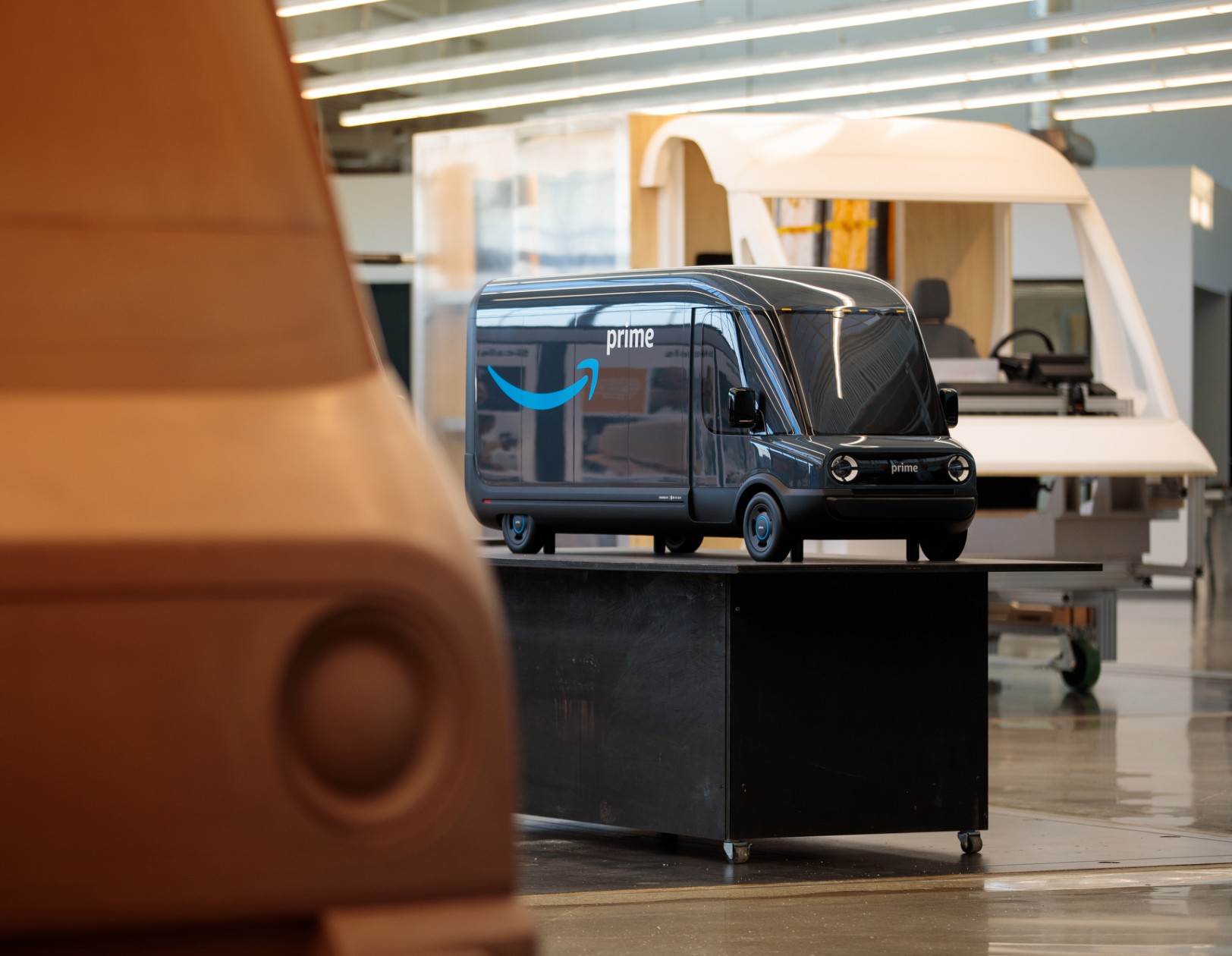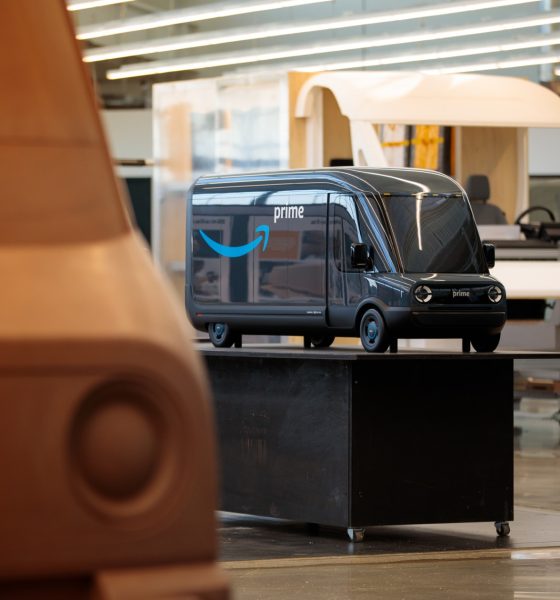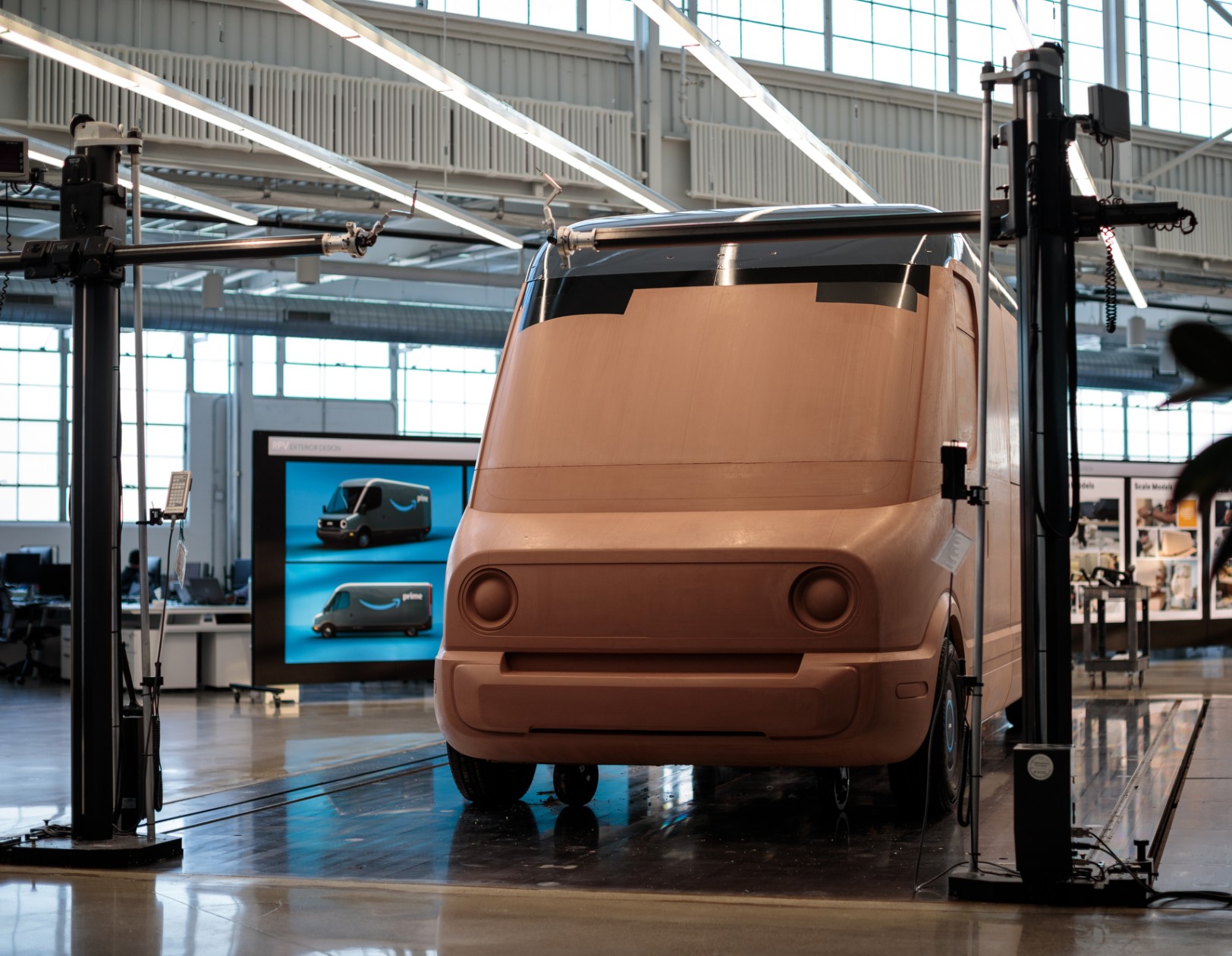

News
Amazon reveals design of its Rivian-powered electric delivery van
Amazon has revealed the design of its upcoming all-electric delivery vehicle, produced in partnership with Rivian.
The $1 trillion dollar e-commerce giant has taken the wraps off a life-size clay model and a small-scale model of its planned delivery van. Unsurprisingly, the all-electric vehicle looks very similar to the current Amazon Prime delivery vans, but with slightly rounded design cues and improved ergonomics and safety features.
Last year, Amazon announced that it has teamed up with electric truck startup Rivian to produce a massive 100,000-unit fleet of electric delivery vans. Amazon says it spent 18 months analyzing electric delivery truck options on the market until it decided to build its own custom van designed specifically for its delivery business.
The latest development reveals how far the Amazon-Rivian partnership has gone toward meeting Amazon’s goal of sending the first of the 100,000 vans delivering packages to American homes by 2021. Amazon hopes to get 10,000 of its electric vans deployed by 2022 and all 100,000 by the end of the decade.
Both the small-scale and life-size clay models were designed at the Rivian headquarters in Plymouth, Michigan, where rows of design boards featuring numerous versions of the Amazon delivery van fill an entire side of the studio.

In another room, Rivian has put together a virtual reality simulation setup to allow drivers to test the new driving experience and offer suggestions for improvement. Amazon says it has consulted heavily with its drivers in working on the truck’s final design, considering certain factors such as loading and unloading of packages, ease of getting in and out of the van, and seat comfort.
“We’re focused on driving efficiency into every aspect of the vehicle design—everything from cabin heating to driver ergonomics to drivetrain design has been optimized for time and energy,” says Rivian CEO RJ Scaringe.
Amazon says the van will be in three sizes with multiple battery configurations to suit various delivery routes. It will come with front-wheel and all-wheel driving options for different terrains and a variety of safety technologies, including automated emergency brakes, lane-keep assist, and a pedestrian warning system. The dashboard will include Amazon’s logistics management system and will provide drivers with the most efficient routes for delivery. It will also integrate Alexa to allow drivers to make hands-free voice commands.
Amazon’s plan to build its own fleet of electric delivery vans is part of its Climate Pledge, a commitment to meet the Paris Agreement in 10 years.
“When we succeed, if we displace those gasoline vehicles with electric vehicles, it will be a large step forward in making our package delivery business sustainable and it has a positive impact on the environment,” says Ross Rachey, director of global last-mile at Amazon.
Amazon is not the only major company that has partnered with Rivian. In January, Ford announced that it is working with Rivian to produce the first electric truck for its Lincoln luxury brand. The startup is also gearing up to release two of its own electric vehicles, the R1T pickup truck, and the R1S SUV, both of which are built on Rivian’s flat-frame skateboard platform. Both vehicles will also come integrated with Alexa.

News
Tesla aims to combat common Full Self-Driving problem with new patent
Tesla writes in the patent that its autonomous and semi-autonomous vehicles are heavily reliant on camera systems to navigate and interact with their environment.

Tesla is aiming to combat a common Full Self-Driving problem with a new patent.
One issue with Tesla’s vision-based approach is that sunlight glare can become a troublesome element of everyday travel. Full Self-Driving is certainly an amazing technology, but there are still things Tesla is aiming to figure out with its development.
Unfortunately, it is extremely difficult to get around this issue, and even humans need ways to combat it when they’re driving, as we commonly use sunglasses or sun visors to give us better visibility.
Cameras obviously do not have these ways to fight sunglare, but a new patent Tesla recently had published aims to fight this through a “glare shield.”
Tesla writes in the patent that its autonomous and semi-autonomous vehicles are heavily reliant on camera systems to navigate and interact with their environment.

The ability to see surroundings is crucial for accurate performance, and glare is one element of interference that has yet to be confronted.
Tesla described the patent, which will utilize “a textured surface composed of an array of micro-cones, or cone-shaped formations, which serve to scatter incident light in various directions, thereby reducing glare and improving camera vision.”

The patent was first spotted by Not a Tesla App.
The design of the micro-cones is the first element of the puzzle to fight the excess glare. The patent says they are “optimized in size, angle, and orientation to minimize Total Hemispherical Reflectance (THR) and reflection penalty, enhancing the camera’s ability to accurately interpret visual data.”
Additionally, there is an electromechanical system for dynamic orientation adjustment, which will allow the micro-cones to move based on the angle of external light sources.
This is not the only thing Tesla is mulling to resolve issues with sunlight glare, as it has also worked on two other ways to combat the problem. One thing the company has discussed is a direct photon count.
CEO Elon Musk said during the Q2 Earnings Call:
“We use an approach which is direct photon count. When you see a processed image, so the image that goes from the sort of photon counter — the silicon photon counter — that then goes through a digital signal processor or image signal processor, that’s normally what happens. And then the image that you see looks all washed out, because if you point the camera at the sun, the post-processing of the photon counting washes things out.”
Future Hardware iterations, like Hardware 5 and Hardware 6, could also integrate better solutions for the sunglare issue, such as neutral density filters or heated lenses, aiming to solve glare more effectively.
Elon Musk
Delaware Supreme Court reinstates Elon Musk’s 2018 Tesla CEO pay package
The unanimous decision criticized the prior total rescission as “improper and inequitable,” arguing that it left Musk uncompensated for six years of transformative leadership at Tesla.

The Delaware Supreme Court has overturned a lower court ruling, reinstating Elon Musk’s 2018 compensation package originally valued at $56 billion but now worth approximately $139 billion due to Tesla’s soaring stock price.
The unanimous decision criticized the prior total rescission as “improper and inequitable,” arguing that it left Musk uncompensated for six years of transformative leadership at Tesla. Musk quickly celebrated the outcome on X, stating that he felt “vindicated.” He also shared his gratitude to TSLA shareholders.
Delaware Supreme Court makes a decision
In a 49-page ruling Friday, the Delaware Supreme Court reversed Chancellor Kathaleen McCormick’s 2024 decision that voided the 2018 package over alleged board conflicts and inadequate shareholder disclosures. The high court acknowledged varying views on liability but agreed rescission was excessive, stating it “leaves Musk uncompensated for his time and efforts over a period of six years.”
The 2018 plan granted Musk options on about 304 million shares upon hitting aggressive milestones, all of which were achieved ahead of time. Shareholders overwhelmingly approved it initially in 2018 and ratified it once again in 2024 after the Delaware lower court struck it down. The case against Musk’s 2018 pay package was filed by plaintiff Richard Tornetta, who held just nine shares when the compensation plan was approved.
A hard-fought victory
As noted in a Reuters report, Tesla’s win avoids a potential $26 billion earnings hit from replacing the award at current prices. Tesla, now Texas-incorporated, had hedged with interim plans, including a November 2025 shareholder-approved package potentially worth $878 billion tied to Robotaxi and Optimus goals and other extremely aggressive operational milestones.
The saga surrounding Elon Musk’s 2018 pay package ultimately damaged Delaware’s corporate appeal, prompting a number of high-profile firms, such as Dropbox, Roblox, Trade Desk, and Coinbase, to follow Tesla’s exodus out of the state. What added more fuel to the issue was the fact that Tornetta’s legal team, following the lower court’s 2024 decision, demanded a fee request of more than $5.1 billion worth of TSLA stock, which was equal to an hourly rate of over $200,000.
Delaware Supreme Court Elon Musk 2018 Pay Package by Simon Alvarez
News
Tesla Cybercab tests are going on overdrive with production-ready units
Tesla is ramping its real-world tests of the Cybercab, with multiple sightings of the vehicle being reported across social media this week.

Tesla is ramping its real-world tests of the Cybercab, with multiple sightings of the autonomous two-seater being reported across social media this week. Based on videos of the vehicle that have been shared online, it appears that Cybercab tests are underway across multiple states.
Recent Cybercab sightings
Reports of Cybercab tests have ramped this week, with a vehicle that looked like a production-ready prototype being spotted at Apple’s Visitor Center in California. The vehicle in this sighting was interesting as it was equipped with a steering wheel. The vehicle also featured some changes to the design of its brake lights.
The Cybercab was also filmed testing at the Fremont factory’s test track, which also seemed to involve a vehicle that looked production-ready. This also seemed to be the case for a Cybercab that was spotted in Austin, Texas, which happened to be undergoing real-world tests. Overall, these sightings suggest that Cybercab testing is fully underway, and the vehicle is really moving towards production.
Production design all but finalized?
Recently, a near-production-ready Cybercab was showcased at Tesla’s Santana Row showroom in San Jose. The vehicle was equipped with frameless windows, dual windshield wipers, powered butterfly door struts, an extended front splitter, an updated lightbar, new wheel covers, and a license plate bracket. Interior updates include redesigned dash/door panels, refined seats with center cupholders, updated carpet, and what appeared to be improved legroom.
There seems to be a pretty good chance that the Cybercab’s design has been all but finalized, at least considering Elon Musk’s comments at the 2025 Annual Shareholder Meeting. During the event, Musk confirmed that the vehicle will enter production around April 2026, and its production targets will be quite ambitious.








